 Research Article
Research Article
Project Monitoring and Early Warning of Time-Cost Overruns in Earned Value Management
Mohammad Azim Eirgash* and Yusuf Baltaci
Karadeniz Technical University, Trabzon, Turkey
Mohammad Azim Eirgash, Department of Civil Engineering, Faculty of Engineering, Karadeniz Technical University, Trabzon, Turkey.
Received Date: August 10, 2021; Published Date: August 27, 2021
Abstract
Project monitoring and control processes are crucial aspects of project management. To perform an appropriate project tracking, Earned Value Analysis (EVA) has to be implemented to help the project managers to measure project performances. A tool to monitor and control the cost, time and work done of a construction project. Furthermore, it also provides an “Early Warning” signal for immediate corrective action. Thereby, in this study, some work items related to a completed real life construction project were evaluated according to the method of Earned Value and the result implies that the analysis can be very useful in project forecasting and decision making relevant to early warnings.
Keywords: Project management; Earned value analysis; Performance indices; Scheduling; Variances
Introduction
The main objective of project management is to meet all project requirements within budget forecasts and the planned time-line. To achieve this goal, it is necessary to put substantial managerial efforts for which project stakeholders are responsible. Creating the effective performance monitoring system plays vital rule in this managerial process. Irrespective of the having project careful planning, without timely and proper performance control, to evaluate the project progress and execution efficiency of the construction project is a nightmare. Monitoring and control system also helps in providing feedbacks to management on the different schedules prepared earlier, in order to ensure that the project is progressing as per schedule. It compares the planned amount of work with what has actually been completed, to determine if cost, schedule, and work, accomplished are progressing as planned. It also provides data for preparing reports for management information system. In today‘s high computational world a construction project works in a dynamic environment and situations, constraints, etc., keep on changing. Hence, it is absolutely necessary to monitor the project at regular intervals and adopt suitable controlling measures in order to keep the project on track. For this purpose, construction organizations have project monitoring and control systems in place.
Efficiency of EVA application to meet project criterion elaborated by several researches e.g. De Marco [1], Souza [2], Chou [3] and Joby [4]. In addition to this earned values analysis has used triangular fuzzy time by utilizing triangular fuzzy number as well as bottom-up hierarch guess procedure considering the design control mechanism to tackle multi-product planning problems. Furthermore, there is no precise control system for measuring the quality of work-done on individual tasks in addition to variation in cumulative earned value appears to be a weakness point of this method. Long Chena [5] proposed a fundamental methodology to enhance the performance prediction of planned value by advanced modelling PV obtaining a trustworthy forecasted results about earned value. In a literature search, identified Earned Value Analysis as a good method for better project management. With this method, cost, timeline and scope are combined and progress performance and it is stated that it can be used to estimate project completion dates. Agata [6] explained that if Earned Value Analysis is applied, this method should be used appropriately; He stated that it makes it easier to monitor progress on the project, determine the status of the project (on time and budget), to roughly estimate their overall impact on the outcome of the project. In another study by Shaik et al. [7], focused on the timely completion of a construction project, the monitoring and control role offered by Earned Value Analysis was examined throughout the project. Eirgash et al. [8] has presented performance scale of an example problem suing the theoretical and practical dimension the earned value analysis, and therefore helped in practical application of the current construction project. Lipke [9] has demonstrated a defined system by which total project cost as well as time duration of a project is likely to be determined to assist the project managers to make intelligent decisions. Figure 1 clearly describes the earned value analysis chart (Figure 1).
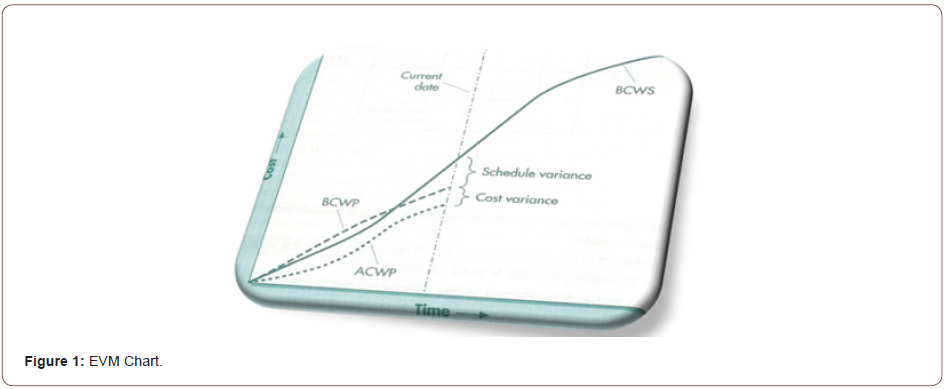
Following is the paper arrangement: Firstly basic concept, straightaway the importance of the construction project relevant to the Earned value analysis is given in well-figured explanations. A small scale example problem is considered to exhibit the effectiveness of earned value analysis in construction projects. Ultimately, discussion and conclusion are presented in order [10- 12].
Basic Concepts of Earned Value Method
In this section, explanation about the earned value analysis terms is illustrated in Table 1. Basic concepts of the EVM are given in Figures 2-4 (Table 1) (Figures 2-4).
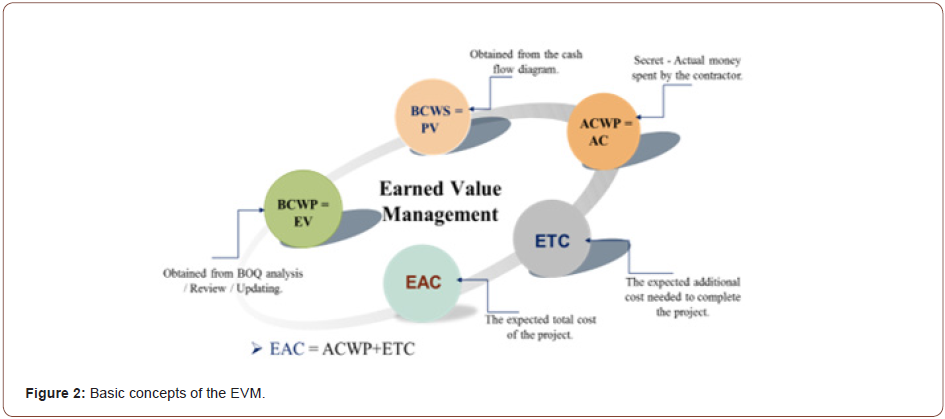
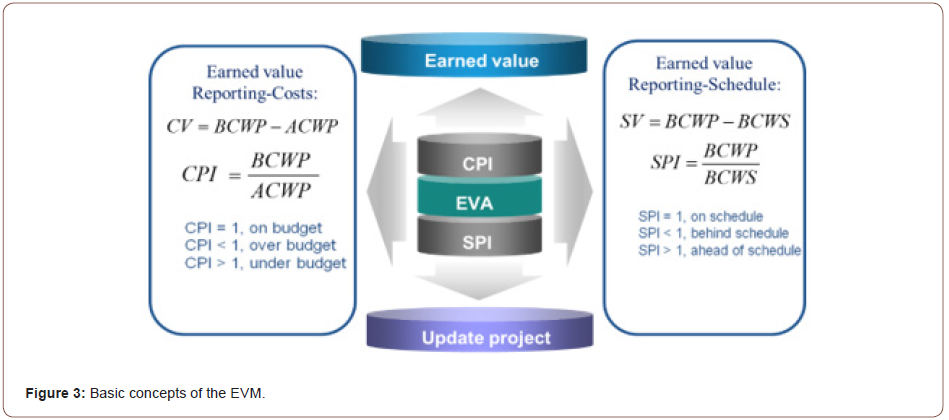
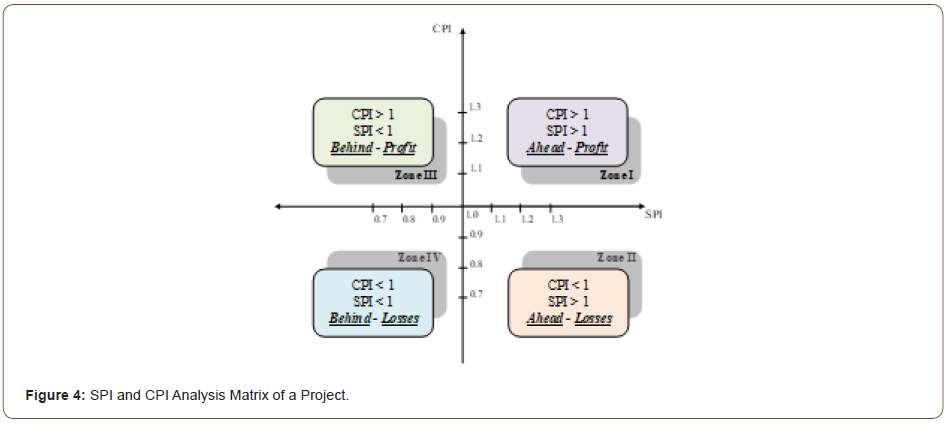
Table 1: Earned value terms.

where ρ is the mass density, v is the velocity, T is the symmetric Cauchy stress tensor, b is the body force. The balance of energy is written in the form
Application
During the summer of 2009 in the building of the closed sports hall faced a big problem in the construction phase, and specifically the problem was in the rebar. This problem was discovered later on, after the completion of the process of pouring the foundations and Ground beams. The project area 1744 m2, according to the contract for Project 340 day, every day of delay will be paid 600$. In the initial planning phase was the work of a timetable for the project using Primavera 6.0 were created for the project (330 days), but the maximum duration of the contract 340 days within any period allowed by. The cost of the project 2,828,241$. (Table 2) (Figure 5)
Table 2: Represents the status report of the project.

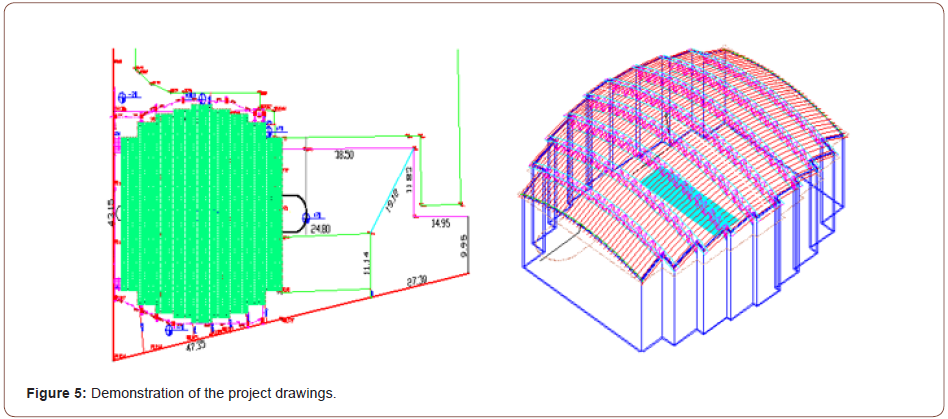
Results and Discussion
Update process of project with earned value analysis
Table 3: Obtained values of status report of the project.

After the work schedule and start the implementation, we need to update the project data into compare the project actually and the planned project and the impact on the schedule. Will now be an update of the project data and follow-up activities during the 3 months from 1 \ 3 \ 2009 to 1 \ 6 \ 2009 using the theory of earned value. As we can by using this value follow-up project in terms of time and cost, sometimes called financial values gained with time and which we can make the right decisions to return the original project if there is a deviation from the previously planned. Estimate to complete as well as estimate at completion are considering the data in Table 1, indices and relevant comments are stated using the plotted graphics (Table 3) (Figure 6).
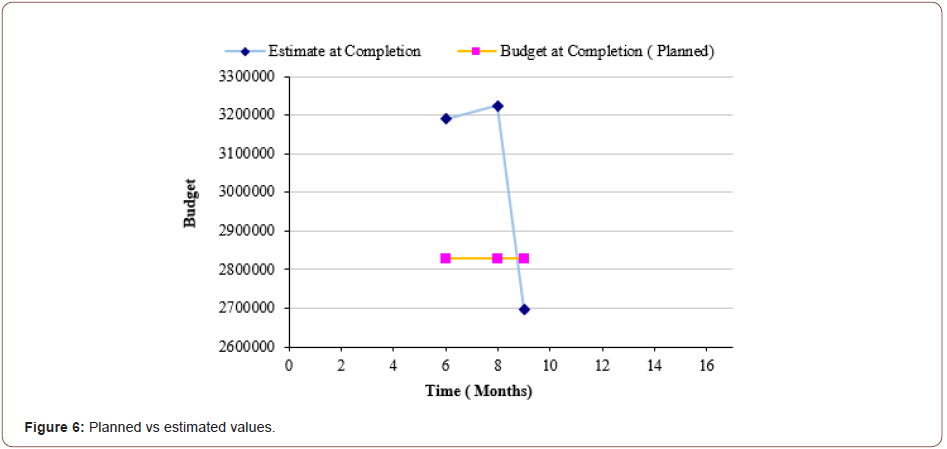
Based on the analysis of the status report and graphical representation in Figure 6, the estimated cost of the project at completion for the 7th month of the updating (after 40% of the project execution) is estimated to have a considerable cost overrun and schedule lagging behind (Figure 7).
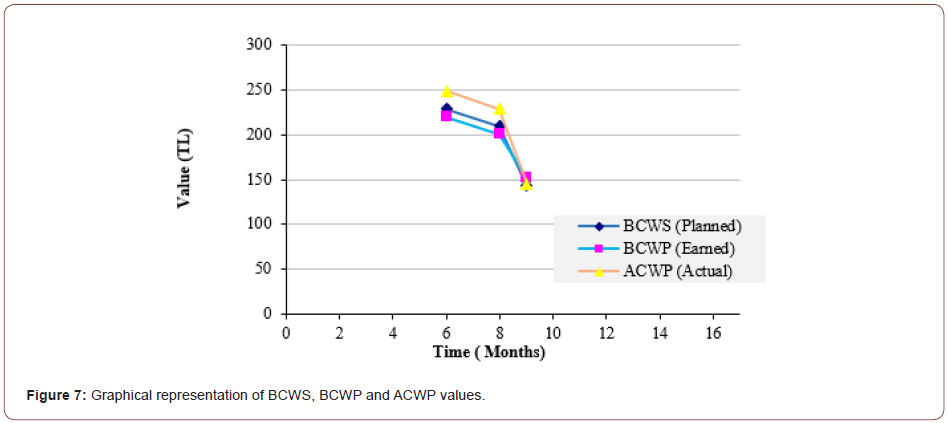
Based on the Figure 7 and 8 which are interconnected to each other, the earned value of the project for the 7th month of the updating explains that both the CV and SV are smaller than zero which express that the project is behind schedule and having cost overrun. In case of 9th month updating both the CV and SV are greater than zero which implies that the project is ahead of the schedule and making profit. By analyzing the graphical representation of CPI and SPI indices in Figure 9, the following comments can be stated.
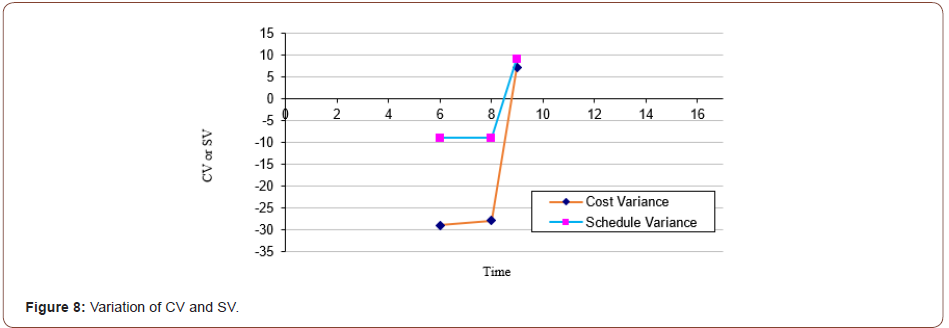
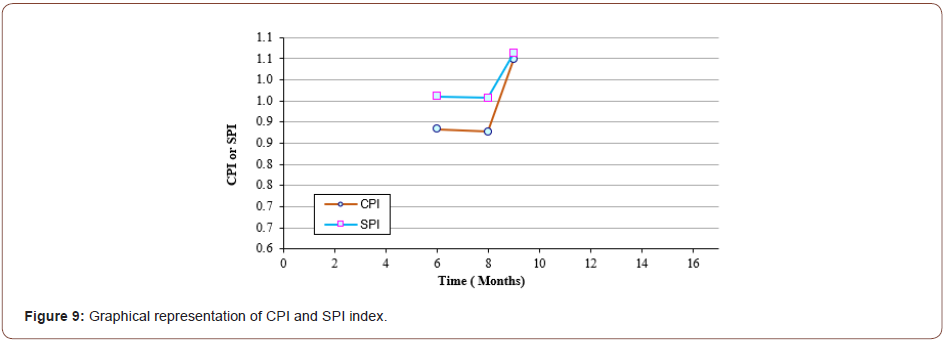
Review of the project on the 7th month
Based on the Figure 9 representation, CPI and SPI both are less than 1.0, CPI<1 indicates a weak cost performance. That earned value is short of what the real costs for this reporting period. Cost performance index (CPI) between 0.95-0.96 indicate cost overrun and behind schedule (Figures 8,9).
9th month review project
It is clear that values of CPI and SPI are greater than 1.0 reveal a good project performance. Also, the project is ahead of schedule, which is a bit better than the previous status report and CPI >1 the project is making loss. According to the graphical indication of CPI and SPI in Figure10. The following remarks can be stated (Figure10).
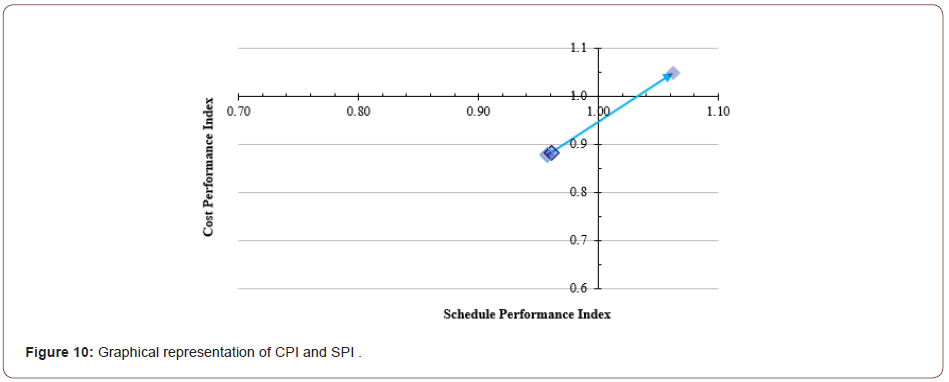
Summary and Conclusion
As it is clear that to provide information on performance of the construction projects, earned value is found to be effective technique. Project stakeholders are likely to get to know timely regarding the scope, schedule, and cost status information of the relevant project. Accomplishment of the projects with a success is associated with the significant factors e.g. .application of earned value analysis with its means at the right time and right manager. The main reason behind the utilizing this method is to stay far away from schedule delay and over budgeting. Therefore, analyzing the indices it can be concluded that each day one of the actual duration was obtained only 0.96 of the value of planned, in other words that the productivity of the project is only 0.96 of the planned. And this also means that each and every one $ of the actual cost was obtained only 0.88 of the value of planned.
Recommendation
Procurement management as well as fuzzy based earned value analysis with time cost trade off optimization models are likely to be favorable topics for future studies.
Acknowledgement
None.
Conflict of Interest
No conflict of interest.
References
- De Marco A, Briccarello D, Rafele C (2009) Cost and schedule monitoring of industrial building projects: Case study. Journal of Construction Engineering and Management 135(9): 853-862.
- Souza AD (2019) A Systematic Review Based on Earned Value Management and Quality. International conference on information Technology pp.135-141.
- Chou J-Sheng, Hung-Ming Chen, Chuan-Chien Hou, Chun-Wei Lin (2010) Visualized EVM system for assessing project performance. Automation in Construction 19(5): 596-607.
- Joby DB Christine U, Roger Joby (2018) Conditions of success for earned value analysis in projects. International Journal of Project Management 36(3): 474-484.
- Long Chena H, Wei T Chen, Ying L Lin (2016) Earned value project management: Improving the predictive power of planned value. International Journal of Project Management 34(1).
- Vargas R (2004) Using earned value management indexes as team high tech R&D environments. Project Management Institute.
- Shaik MM, Devanand R, Harsha HN (2014) An analysis on resource planning, cost estimation & tracking of project by earned value management. International Journal of Engineering & Innovative Technology 4(4): 42-48.
- Eirgash MA, Toğan V, Kazaz A (2017) Application Earned Value Based Metrics to Enhance the Performance Measurement of Engineering Project Management. Nevsehir Journal of Science and Technology 6: 431-439.
- Lipke (2004) The probability of success. The Journal of Quality Assurance Institute pp. 14-21.
- Mohammad A Eirgash (2019) Earned Value Analysis for Construction Projects Using Project Management Scheduling Engine. American Journal of Civil Engineering 7(5): 121-125.
- Lukas J (2008) Earned value analysis–why it doesn't work? Ebsco-Host connection.
- Czarnigowska A (2008) Earned value method as a tool for project control. Budownictwo i Architektura 3(2): 15-32.
-
Mohammad Azim Eirgash, Yusuf Baltaci. Project Monitoring and Early Warning of Time-Cost Overruns in Earned Value Management. Cur Trends Civil & Struct Eng. 7(5): 2021. CTCSE.MS.ID.000673.
-
Project management, Earned value analysis, Performance indices, Scheduling, Variances, Construction project
-

This work is licensed under a Creative Commons Attribution-NonCommercial 4.0 International License.






